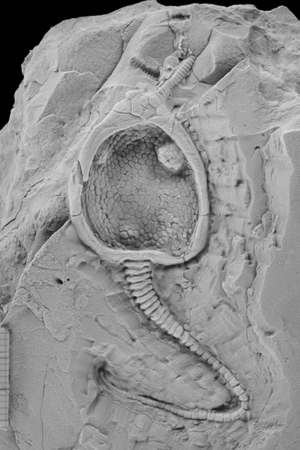
Till now, when scientists and engineers have developed mushy robots impressed by organisms, they’ve centered on modern-day residing examples. As an illustration, we beforehand reported on mushy robotic purposes that mimicked squid, grasshoppers, and cheetahs. For the primary time, nevertheless, a workforce of researchers has now mixed the ideas of soppy robotics and paleontology to construct a soft-robot model of pleurocystitid, an historical sea creature that existed 450 million years in the past.
Pleurocystitids are associated to modern-day echinoderms like starfish and brittle stars. The organism holds nice significance in evolution as a result of it’s believed to be the first echinoderm that was able to transferring: It employed a muscular stem to maneuver on the ocean mattress. However, as a result of a scarcity of fossil proof, scientists never clearly understood how the organism really used the stem to maneuver underwater. “Though its life habits and posture are moderately properly understood, the mechanisms that management the motion of its stem are extremely controversial,” authors of a beforehand printed examine specializing in the echinoderm stem note.
The newly developed soft-robot reproduction (additionally known as the “Rhombot”) of a pleurocystitid has allowed researchers to decode the organism’s motion and varied different mysteries linked to the evolution of echinoderms. Of their examine, additionally they declare that the reproduction will function the muse of paleobionics, a comparatively new discipline that makes use of mushy robotics and fossil proof to discover the biomechanical variations amongst life varieties.
Making a mushy robotic reproduction
There are numerous the reason why scientists don’t try and make a mushy robotic model of one thing extinct and as previous as pleurocystitid. It’s tough to know how the organism moved as a result of there is no such thing as a modern-day analog. Plus, fossil proof solely offers restricted details about how an organism moved. As an illustration, whereas some researchers recommend that pleurocystitid swam, others argue that it exhibited sculling or sinusoidal actions.
To beat these challenges, the researchers labored with paleontologists who focus on echinoderms. They collected fossil photographs, CT scans, and all the opposite proof they might discover after which used this information to design the pleurocystitid’s physique and stem. Subsequently, they employed elastomer casting and 3D printing to assemble the varied elements of the robotic primarily based on the design.

After they tried to make the robotic transfer utilizing the stem (like the actual pleurocystitid), they had been confronted with one other problem. “The mushy actuator used nitinol wire, a form reminiscence alloy (SMA) that will typically burn out and turn out to be completely stretched. This required making many stems (practically 100 stems had been made) and changing them after they went unhealthy,” Richard Desatnik, lead researcher and a PhD scholar at Carnegie Mellon College (CMU), instructed Ars Technica.
It was additionally difficult to copy the mushy muscular stem of the pleurocystitids, for the reason that researchers couldn’t use typical motors, that are too cumbersome and inflexible. “As a substitute, we wanted to make use of a particular ‘synthetic muscle’ wire composed of nickel and titanium alloy that contracts in response to electrical stimulation. This allowed us to create a stem-like actuator that matched the flexibleness of a pure muscular stem,” Carmel Majidi, senior examine creator and a professor of mechanical engineering at CMU, added.
The researchers then ran some simulations to see how the Rhombot would seemingly transfer underwater. They found {that a} longer stem resulted in higher motion. In keeping with the examine, this was according to fossil proof suggesting the evolution of longer stems in pleurocystitids over time.
After finding out the simulations, the researchers positioned the robotic in a 42×42-inch fish tank with a backside floor just like a seabed. They performed a number of checks, every lasting two minutes, to look at the robotic’s motion. “We demonstrated that vast, sweeping gaits might have been the best for these echinoderms and that growing stem size may need considerably elevated velocity with minimal further power price,” the researchers note of their examine.
Learning extinct animals
Making useful replicas of extinct historical creatures utilizing paleobionics sounds fairly attention-grabbing, however what can robots inform us that the fossil file can’t? Once we posed this query to Majidi, he defined that by solely specializing in robots impressed by current species, scientists could also be shedding a giant alternative to be taught the organic and evolutionary ideas that ruled the lives of quite a few different life varieties.
As an illustration, in line with an estimate, modern-day residing organisms comprise only 1 percent of all of the life that ever existed on Earth. “We are able to start to be taught from the 99 % of species that when roamed the earth as an alternative of simply the 1 %. There are many creatures that had been profitable for tens of millions of years and died out as a result of drastic modifications of their atmosphere,” Majidi instructed Ars Technica.
Smooth robotic replicas of such creatures equip paleontologists with a robust device to create experimental testbeds for inspecting hypotheses about how these historical life varieties moved and advanced.
The present examine efficiently demonstrates that mushy robotics can doubtlessly be used to “resurrect” extinct organisms and examine their locomotion and biomechanics. “It had by no means been performed earlier than throughout the mushy robotics neighborhood, and we hope it conjures up extra analysis within the discipline,” Desatnik added.
PNAS, 2023. DOI: 10.1073/pnas.2306580120 (About DOIs)
Rupendra Brahambhatt is an skilled journalist and filmmaker. He covers science and tradition information, and for the final 5 years, he has been actively working with a few of the most progressive information companies, magazines, and media manufacturers working in numerous elements of the globe.
